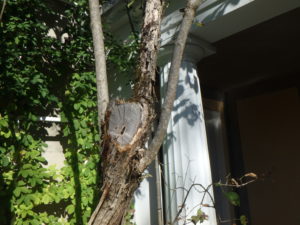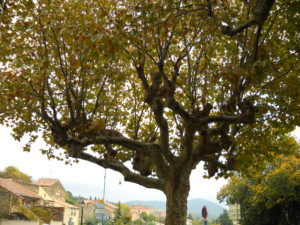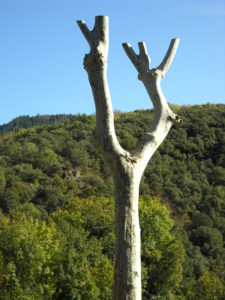Winter Pruning
This is a time of year when little is happening in the garden. Weeds either have been pulled, or won’t be – until next spring. I’ve cut back most flowers, both perennial and annual. The ground is starting to freeze and we’ve had some snow. It’s a good time to be lazy. But … I don’t like to be lazy.
So what can a gardener do? Prune. Trees and shrubs are dormant now, and it is fine to do some pruning. You can see the structure of deciduous woody plants easily now, as their leaves have dropped.
Before you start hacking away, be advised that shrubs that bloom in spring or early summer already have their flower buds ready and waiting for spring. So if you prune heavily, you will lose blossoms. On the other hand, if you have the time now and the plants need work, get to work.
In fact, most shrubs and fruit trees have both their leaf and flower buds. A few exceptions exist, of course: hydrangeas, summer sweet clethra, seven-sons flower tree, witchhazel and franklinia come to mind as woody plants that set their blossom buds on new wood in the spring for summer or fall blooming.
On a recent day I went out to do some radical pruning. I have a white lilac that had gotten too tall. It was 15 or 20 feet tall, and the blossoms were out of reach – and largely out of sight when blooming. It was like that when I bought my house, eons ago, and I cut it right to the ground back then, every bit of it. I didn’t care if it died. In fact I kind of hoped it would because it was so out of control. But the roots sent up new growth and if was a nice sized shrub a while. But life gets busy and all of a sudden it was too tall again. This time I was a bit more controlled.
I have been observing old lilacs to see what others have done with them, and how the plants have responded. At Saint Gaudens National Park I saw that the groundskeeper had cut back old lilacs to about 5 or 6 feet above ground, and that new branches had sprouted from dormant buds on those stems. I’m sure they looked pretty gawky for a year or two, but vigorous new growth had filled in. I decided to try the same.
So I cut back the lilacs, reducing their height to 4 to 6 feet. There will be no blossoms this year, and probably not next year. But there are a few root sprouts that have stems an inch thick, and those may produce blossoms. I just have to make sure those stems don’t reach for the sky.
You might wonder why my lilacs have gotten so tall. I think the answer is that they don’t get enough sunshine. There is a row of sugar maples only about 25 feet away from them, and these create more shade on my lilacs every year. Plants tend to grow tall and lanky if they are sunshine-deprived. They reach for the sun.
Elsewhere on my property that day I cut back my seven sons flower tree (Heptacodium miconiodes). This is a very vigorous fall-blooming tree I’ve had for 15 years or more. It can grow a shoot 6 feet in a year, once established. It is within eight feet of my house, and some of the branches were acting like voyeurs, trying to peak in my bedroom window. They needed some attention.
On one 10-foot stem I cut off all the branches. I am experimenting with a pruning technique called pollarding. This technique is commonly employed with English plane trees in Europe, and I like the look. Every few years trees are cut back to their trunks. The branch locations get scarred, and develop big lumps that then produce multiple new, vigorous branches.
Pollarding is particularly good for fast growing, weak-wooded trees. If those English plane trees were not cut back from time to time, the branches would likely break off from their own weight. That would be dangerous, as they are commonly planted along town streets and in parks. They are great shade trees.
I wouldn’t recommend cutting off all limbs on a tree and leaving just the trunk until you have tried pollarding part of the tree to see how it responds. I have read, for example, that one can pollard maples, oaks and beeches, but I wonder if they would perform well. They don’t grow as fast as some trees, and might take too long to develop an interesting appearance. Or try pollarding a small tree in a not-so prominent place to see how it does.
Fruit trees are most often pruned in late winter or early spring, but you can prune them now if you wish. We have some snow now, which makes ladder work more difficult, but a well-pruned apple tree can be a pleasant sight all winter. So have at it!
Henry’s gardening books are available from his website, www.Gardening-Guy.com. You may read his blog posts at https://dailyuv.com/
Pollarding Trees
On a recent trip to southern France I was fascinated by what some people might term “tree abuse”. The French love to turn certain trees into sculpted forms by removing all new growth each year – or most, depending on the age of the tree. The English term for this type of pruning is “pollarding”. I have decided I shall give it a try.
The English plane tree (Platanus x. acerifolia) is the most commonly pollarded tree in southern France, though I have seen other fast-growing trees treated the same way, notably lindens (Tilia spp). Plane trees are reminiscent of our sycamores (Platanus occidentalis), with bark that looks a bit like the patterns and colors of camouflage clothing. They are commonly used to line city streets and rural lanes.
The plane tree is fast growing and survives in most places – even along the Canal du Midi, the seventeenth-century canal that connects the Mediterranean to the Atlantic. I spent a day biking the canal and was amazed to see plane tree roots cross the towpath and reach into the water – like pythons slithering out of the earth and into the canal. But I noticed that the plane tree sheds branches freely, dropping small branches onto my path. I gather it is a somewhat weak-wooded tree, though perhaps not as weak as our willows (Salix spp.) or box elder (Acer negundo).
Driving through the town of Puisserguier, in the Languedoc, I admired the ‘allees’ or rows of plane trees that lined their streets. Then one day I came back and saw that all new growth had been cut off, creating an eerie, Edward Gorey-like atmosphere. Workers with a boom truck were just finishing up a major task, clearing out the clutter by cutting off all the upper branches.
These big trees showed huge knobs, scars where this had been done many times. I spoke to a tree specialist, who explained that plane tree branches can grow 6-9 feet per year, so they cut off all new growth on mature trees every other year. By cutting back the smaller branches to the trunk or a major branch, much weak wood is eliminated and weight taken off the major branches. It keeps trees from getting too tall. And it creates wonderful sculpture.
Another benefit of pollarding a tree is that it creates dense shade. Cutting back the trees encourages them to send out multiple shoots. From the scarred knobs created in previous years, a half dozen branches will erupt. That creates dense foliage. The Mediterranean sun is hot in summer, and town squares are generally shaded from its intensity by pollarded plane trees, much as our American elms once shaded Main Street.
When I return from France I will experiment with my seven-sons flower tree (Heptacodium micinioides). This is a fast-growing tree that blooms in the fall; the blossoms are small, white and lightly fragrant. It is originally from China, and has only started to become popular in the nursery trade in the last 20 years. I got mine about 10 years ago at EC Brown Nursery in Thetford, Vermont (www.ecbrownsnursery.com).
It is a medium-sized tree – the largest specimen I’ve seen is about 30 feet tall. But it can send up shoots 6 feet in a year, and I have struggled to keep mine the size and shape I want. It is near the house and several times it has attempted to send shoots indoors through a second-floor window. So I have pruned it hard, but never removed enough branches to create a pollarded look. The main trunk is now about 4-inches or more in diameter and 10 feet tall. It has one major bifurcation – where the trunk branches into 2 major branches. So I will cut off all the branches back to those two branches. Later, I may let a single new stem continue to grow and thicken, creating a higher point for pollarding.
So what else have I learned in France? I think I pamper some of my plants too much. I know that thyme, rosemary and lavender thrive in lean soil that is low in fertility. But it is hard for me to deny them some compost at planting time. Off-road biking here I have found them growing wild – thriving – in sandy dry soil, which should be a lesson to me.
Similarly, grapes here do fabulously in dry, rocky soil. One vintner, an organic grower at Domaine Bordes (A.O.C. Saint Chinian) told me that he uses no fertilizer. He said that his grapes do just fine, producing great flavor – but in smaller quantities than conventional growers who use chemical fertilizers. Grape growers often mulch with gravel in France, a technique I haven’t yet tried.
Lastly, I saw sheep’s wool used as mulch around trees. There is not much market for raw wool in France – or in the States. If you have a friend with sheep or llamas, you might be able to get some wool. It will keep down weeds, hold in moisture, and slowly break down, providing some nitrogen. Still, I’m not sure I like the look – perhaps it would be good in my blackberry patch, or around apple trees that are not in view every day.
So if you travel, observe. And send me your observations – we can all learn new techniques from each other, and from different cultures.
Contact Henry at henry.homeyer@comcast.net or P.O. Box 364, Cornish Flat, NH 03746.







